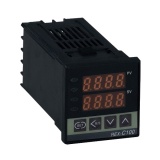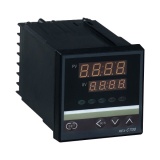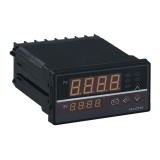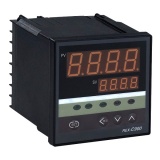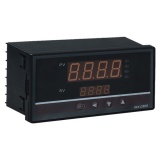Economical Temperature Controller REX series
General Introduction:
REX series PID Temperature Controller are the economical series. It adopts special microcomputer adjusting meter that employs switching power and surface mount technology (SMT), therefore, the controller is quite smart and reliable. Its special functions like auto diagnosing, auto setting and intelligent control. It can be used widely in the display and control of the parameter of the temperature, pressure, flow, and liquid level.
Product Features:
• Input: Universal input, support 10 different types of thermocouples and RTD inputs by customers selected at panels.
• Usage in heating control or cooling control
• Display temperature in Celsius (°C)
• Control precision: +/- 0.5%
• Control mode: PID, ON/OFF
• Control Output: Relay contact (3A @ 240 VAC), Voltage impulse output for external SSR, Current 0-20mA, 4~20 mA, Voltage 0-5V,0-10VDC
• Alarm: AL1 or AL2, 7 kinds of alarm mode: high/low/high deviation/low deviation/interval/out of interval/breakage alarm.
• Power Supply: 100~240V AC 50/60Hz, DC24V, or other voltage according your order.
Model Description and Model Selection:
Outline Size Panel Cutout
|
|
|
Model |
A |
B |
C |
D |
E |
F |
G |
H |
|
C100 |
48 |
48 |
10 |
100 |
45 |
45 |
80 |
80 |
|
C410 |
96 |
48 |
10 |
100 |
92 |
45 |
116 |
80 |
|
C400 |
48 |
96 |
10 |
100 |
45 |
92 |
80 |
116 |
|
C700 |
72 |
72 |
10 |
100 |
68 |
68 |
96 |
96 |
|
C900 |
96 |
96 |
10 |
100 |
92 |
92 |
116 |
116 |
REX – C□ 0 0-□ □ □ - □□ * □□
① ② ③ ④ ⑤ ⑥ ⑦ ⑧
1 Outline Size(see the abvoe form)
2 Control Type
F:PID operation and auto calculation(Reverse operation)
D:PID operation and auto calculation(Forward operation)
3.Input Type: refer to input range table
4.Range Code: refer to input range table
5.First Control Output (OUT1) (Heating side)
M: Relay Contact output 8: Current output( DC 4~20mA)
V: Voltage impulse output for SSR T: Hydration driving output
6.Second Control Output (OUT2) (Cooling side)Null: when control operation is F or D
M: Relay Contact output 8: Current output( DC 4~20mA)
V: Voltage impulse output for SSR T: Hydration driving output
7. First Alarm(ALM1) 8.Second Alarm(ALM2)
N: no alarm A: Upper-Limit bias alarm
B: Lower-Limit bias alarm C: Upper/Lower Limit bias alarm
D: Alarm in area
E: Standby upper-limit bias alarm attached
F: Standby lower-limit bias alarm attached
G: Standby upper/lower limit bias alarm attached
H: Upper-Limit input value alarm
J: Lower-limit input value alarm
K: Standby upper-limit input value alarm attached
L: Standby lower-limit input value alarm attached
The Input Range Table:
|
|
Code |
Input Range |
Code |
Input Range |
Code |
Input Range | |||
|
Themocouple Input(TC) |
K |
K01 |
0-200°C |
K02 |
0-400°C |
K03 |
0-600°C | ||
|
K04 |
0-800°C |
K05 |
0-1000°C |
K06 |
0-1200°C | ||||
|
K07 |
0-137 2°C |
K13 |
0-100°C |
K14 |
0-300°C | ||||
|
| |||||||||
|
J |
J01 |
0-200°C |
J02 |
0-400°C |
J03 |
0-600°C | |||
|
J04 |
0-800°C |
J05 |
0-1000°C |
J06 |
0-1200°C | ||||
|
| |||||||||
|
R *1 |
R01 |
0-1600°C |
R02 |
0-1769°C |
R04 |
0-1350°C | |||
|
S *1 |
S01 |
0-1600°C |
S02 |
0-1769°C |
|
| |||
|
B *1 |
B01 |
400-1800°C |
B02 |
0-1769°C |
|
| |||
|
E |
E01 |
0-800°C |
E02 |
0-1000°C |
|
| |||
|
N |
N01 |
0-1200°C |
N02 |
0-1300°C |
|
| |||
|
| |||||||||
|
T *2 |
T01 |
0-350°C |
T02 |
-199.9-100.0°C |
T03 |
-199.9-200.0°C | |||
|
T04 |
-199.9-400.0°C |
|
|
|
| ||||
|
| |||||||||
|
RTD Input |
PT100 |
D01 |
-199.9-649.0°C |
D02 |
-199.9-200.0°C |
D03 |
-199.9-50.0°C | ||
|
D04 |
-100-100.0°C |
D05 |
-100-200.0°C |
D06 |
0.0-50.0°C | ||||
|
D07 |
0.0-100.0°C |
D08 |
0.0-200.0°C |
D09 |
0.0-300.0°C | ||||
|
D10 |
0.0-500°C |
|
|
|
| ||||
|
| |||||||||
|
JPT100 |
P01 |
-199.9-649.0°C |
P02 |
-199.9-200.0°C |
P03 |
-199.9-50.0°C | |||
|
P04 |
-100-100.0°C |
P05 |
-100-200.0°C |
P06 |
0.0-50.0°C | ||||
|
P07 |
0.0-100.0°C |
P08 |
0.0-200.0°C |
P09 |
0.0-300.0°C | ||||
|
P10 |
0.0-500°C |
|
|
|
| ||||
|
| |||||||||
|
Voltage Input |
0-5V |
401 |
0.0-100°C |
|
|
|
| ||
|
1-5V |
601 |
0.0-100°C |
|
|
|
| |||
|
Current Input |
0-20mA |
701 |
0.0-100°C |
|
|
|
| ||
|
4-20mA |
801 |
0.0-100°C |
|
|
|
| |||
|
Note: *1 The accuracy can not be guaranteed in 0-399°C *2 The accuracy can not be guaranteed in -199.9-100°C | |||||||||













